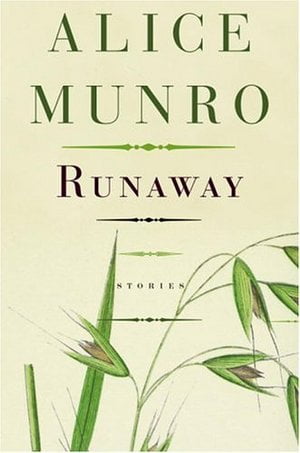The release of the 2007 film Away From Her, a story story based on Alice Munro’s story “The Bear Came Over the Mountain”, reminds one of the author’s prolific career and her immense talent as a wise and magical writer. The film directed by Sarah Polley, and with a cast of Hollywood heavyweights as Olympia Dukakis, Julie Christie and Gordon Pinsent, is a great introduction to this author’s line of work. Additionally, if there a collection of short-stories that truly represent the depth of Munro’s writing abilities, Runaway can arguably be the runaway hit.
In April 2005, Canadian author Alice Munro made Time magazine’s 2005 list of the world’s most influential people. Author Mona Simpson wrote in celebration of this honor, “Munro’s stories have broken out of their forms, expanding the genre. She takes on huge swaths of time, with breathtaking skips and breaks and vision, while still writing about women, about Canadians, about the extraordinary nature of ordinary love.” The Time 100 is designed to be a snapshot of the most influential individuals in any given year. Others on the list this year included U.S. President George W. Bush, talk-show host Oprah Winfrey and the head of Microsoft Bill Gates.
The names on the list are divided into five categories. Alice Munro was included in the “Artists and Entertainers” subsection, alongside Daily Show host Jon Stewart, rapper Kanye West, filmmaker Quentin Tarantino, and The Da Vinci Code author Dan Brown.
Alice Munro was born in 1931 in Wingham, a small town in southwestern Ontario. She received a scholarship to the University of Western Ontario, but left before graduating in order to marry another student, James Munro. She currently divides her time between Clinton, Ontario, not far from Munro’s hometown of Wingham, and Comox, British Columbia.
Munro is the author of ten previous published collection of short stories: Dance of the Happy Shades; Something I’ve Been Meaning to Tell You; The Beggar Maid; The Moons of Jupiter; The Progress of Love; Friend of My Youth; Open Secrets; her Selected Stories; The Love of a Good Woman; and Hateship, Friendship, Courtship, Loveship, Marriage; as well as a novel, Lives of Girls and Women.
She is a three-time winner of the Governor General’s Literary Award, Canada’s highest; the Giller Prize, Canada’s biggest literary award for fiction given to Runaway; the Lannan Literary Award; and the W. H. Smith Award, given to Open Secrets as the best book published in the United Kingdom in 1995. Her stories have appeared in The New Yorker, The Atlantic Monthly, The Paris Review, among other publications, and her collections have been translated into thirteen languages.
Runaway, her latest collection published in 2004, continues with her successful style of revealing to the reader a clear view of the entire life of its characters until the stories are almost real. She explores women of all ages and circumstances, and their friends, lovers, parents, and children revealing the unspoken pressures of these relationships.
In the title story, Munro explores an unwise young woman, Carla and her effort to leave her domineering husband with the help of Sylvia, a neighboring widow. Munro builds the tension of the protagonists struggle by plotting and weighing the story with a symbol in the form of a pet goat. With the animal’s physical disappearance, and then the animal’s physical return, which leaped out of the fog, Carla’s desire to escape her unhappy marriage is contrasted and makes for a clever narrative twist.
Three of the stories are about the same character. In “Chance” Juliet is a studious young teacher in a relentless search for her own identity, in “Soon” she grows into a young mother visiting her elderly parents, and finally in “Silence” as a late middle-aged woman she struggles to locate and reconnect with her own grown daughter. As the stories progress, the reader realizes that the independence and rationalism we had admired in Juliet had alienated her own child, who left in search of the spiritual things she never had at home. These three stories have the scope of novels because when linked they create a series of allied episodes, which are developed in the selectivity of the short-story form.
With her disciplined style, Munro achieves the single effect idea of the short-story form. In this collection, all titles are telling single words as in “Tricks,” “Powers,” and “Trespasses,” that linger in the mind of the reader as the narrative is explored. In some of the stories, as in “Soon” the title word is sparingly present, introduced in dialogue and then distended as one of the final words between Juliet and her ailing mother, “My faith isn’t so simple, said Sara… I can’t describe it. But it’s a wonderful- something. When it gets really bad for me- when it gets so bad I- you know what I think then? I think, all right. I think- Soon. Soon I’ll see Juliet.” Months after Sara’s death Juliet reflected on that last conversation, “When Sara had said, soon I’ll see Juliet, Juliet had found no reply. Why should it have been so difficult? Just to say Yes. To Sara it would have meant so much.” These powerful revelations of the conflict in relationships are Munro’s signature force in fiction today.
Many of Munro’s stories are based on her native Ontario. As stated in Maria Fish’s Runaway review “the collection is set in the barren, often isolated provinces of Canada and spans several decades up through the ’70s. Against this landscape, and with a faultless ear for poignant detail, Munro presents ordinary lives that disguise larger dramas.” Munro singles out the setting in rural Canada “as ‘real’ to me, in a way no other is.”Munro utilizes her landscape to plot the story and develop its theme. This can be perceived from any of the stories in the collection. For instance, in “Passion” Munro utilizes the countryside expansion of the Ottawa Valley to develop distant characters that have secret lives and buried wishes, as if hidden in the expanses of the picturesque lakes and country roads.
In this collection all the protagonists are women whose lives rarely proceed smoothly or logically despite their best efforts. Their plans for themselves are repeatedly tampered with by circumstances, and the truth behind their lives may not reveal itself until decades after the story’s supposed main event. The ultimate outcome can be cruel, as it is in “Tricks,” where one missing piece of vital information changes a whole life making this story the most powerful of the collection.
Some of the stories have an end that may be left for interpretation and creates an openness in the story. For instance, in “Chance” the reader is left to wonder if Juliet chose to stay with Eric or returned to Vancouver. Then, in “Soon” Munro explores Juliet again and the reader discovers that not only did Juliet stay, but also she now had a little girl. In between stories, there is a gap in the narrative that Munro utilizes to express her perception of real time passed as in an actual life. Munro tells in an interview, “I want the stories to keep going on. I want the story to exist somewhere so that, in a way, it’s still happening.”
The wonderful secret to Munro’s insightful writing is her ability to platform the characters entirely in their beauty, hostility, pain, and sorrow. As Munro said in an interview, “I always have to know my characters in a lot of depth–what clothes they’d choose, what they were like at school, etc . . . And I know what happened before and what will happen after the part of their lives I’m dealing with. I can’t see them just now, packed into the stress of the moment.”This unique approach to character development is scarce in today’s writing and readers appreciate it when present.
Munro is a master of her time, a wonderful writer that countless try to imitate, and few manage to succeed on. As Aubrey explores in her article, “to write like Munro, we need to know our material intimately, arrange it in just the right way, then teach our fingers that magic ‘flourish’ which will bring everything together.”Munro has that magical touch in her narrative and her latest collection, Runaway, showcases her style brilliantly.




